 English
English



-
 Afrikaans
Afrikaans -
 Albanian
Albanian -
 Amharic
Amharic -
 Arabic
Arabic -
 Armenian
Armenian -
 Azerbaijani
Azerbaijani -
 Basque
Basque -
 Belarusian
Belarusian -
 Bengali
Bengali -
 Bosnian
Bosnian -
 Bulgarian
Bulgarian -
 Catalan
Catalan -
 Cebuano
Cebuano -
 China
China -
 China (Taiwan)
China (Taiwan) -
 Corsican
Corsican -
 Croatian
Croatian -
 Czech
Czech -
 Danish
Danish -
 Dutch
Dutch -
 English
English -
 Esperanto
Esperanto -
 Estonian
Estonian -
 Finnish
Finnish -
 French
French -
 Frisian
Frisian -
 Galician
Galician -
 Georgian
Georgian -
 German
German -
 Greek
Greek -
 Gujarati
Gujarati -
 Haitian Creole
Haitian Creole -
 hausa
hausa -
 hawaiian
hawaiian -
 Hebrew
Hebrew -
 Hindi
Hindi -
 Miao
Miao -
 Hungarian
Hungarian -
 Icelandic
Icelandic -
 igbo
igbo -
 Indonesian
Indonesian -
 irish
irish -
 Italian
Italian -
 Japanese
Japanese -
 Javanese
Javanese -
 Kannada
Kannada -
 kazakh
kazakh -
 Khmer
Khmer -
 Rwandese
Rwandese -
 Korean
Korean -
 Kurdish
Kurdish -
 Kyrgyz
Kyrgyz -
 Lao
Lao -
 Latin
Latin -
 Latvian
Latvian -
 Lithuanian
Lithuanian -
 Luxembourgish
Luxembourgish -
 Macedonian
Macedonian -
 Malgashi
Malgashi -
 Malay
Malay -
 Malayalam
Malayalam -
 Maltese
Maltese -
 Maori
Maori -
 Marathi
Marathi -
 Mongolian
Mongolian -
 Myanmar
Myanmar -
 Nepali
Nepali -
 Norwegian
Norwegian -
 Norwegian
Norwegian -
 Occitan
Occitan -
 Pashto
Pashto -
 Persian
Persian -
 Polish
Polish -
 Portuguese
Portuguese -
 Punjabi
Punjabi -
 Romanian
Romanian -
 Russian
Russian -
 Samoan
Samoan -
 Scottish Gaelic
Scottish Gaelic -
 Serbian
Serbian -
 Sesotho
Sesotho -
 Shona
Shona -
 Sindhi
Sindhi -
 Sinhala
Sinhala -
 Slovak
Slovak -
 Slovenian
Slovenian -
 Somali
Somali -
 Spanish
Spanish -
 Sundanese
Sundanese -
 Swahili
Swahili -
 Swedish
Swedish -
 Tagalog
Tagalog -
 Tajik
Tajik -
 Tamil
Tamil -
 Tatar
Tatar -
 Telugu
Telugu -
 Thai
Thai -
 Turkish
Turkish -
 Turkmen
Turkmen -
 Ukrainian
Ukrainian -
 Urdu
Urdu -
 Uighur
Uighur -
 Uzbek
Uzbek -
 Vietnamese
Vietnamese -
 Welsh
Welsh -
 Bantu
Bantu -
 Yiddish
Yiddish -
 Yoruba
Yoruba -
 Zulu
Zulu
Exploring the Advancements of NLTC Transformers in Natural Language Processing
Understanding the NLTC Transformer Revolutionizing Natural Language Processing
In the realm of Natural Language Processing (NLP), developments are continuous, with various architectures emerging to improve the understanding and generation of human language. One of the noteworthy innovations is the NLTC (Non-Linear Transformers with Contextual Embedding) Transformer, which expands upon the foundation set by traditional transformers. This article delves into the architecture and functionality of the NLTC Transformer, highlighting its significance in enhancing NLP tasks.
The traditional transformer model, introduced by Vaswani et al. in 2017, has become the backbone of numerous NLP models, including BERT and GPT. It employs an attention mechanism to weigh the influence of different words in a sequence, allowing it to capture long-range dependencies. However, as impressive as it is, conventional transformers often grapple with non-linear relationships in language, which can be complex and nuanced. This is where the NLTC Transformer steps in, providing a novel approach to address these challenges.
Understanding the NLTC Transformer Revolutionizing Natural Language Processing
Moreover, the NLTC Transformer incorporates a contextual embedding layer that enhances the understanding of word meanings based on surrounding context. Traditional embedding methods, like Word2Vec or GloVe, assign fixed vectors to words, which can lead to ambiguous interpretations. The contextual embedding in the NLTC model, however, dynamically adjusts the representation of words, allowing them to take on different meanings depending on their usage within a phrase or sentence. This feature is particularly beneficial for polysemous words – those that have multiple meanings.
nltc transformer

Training the NLTC Transformer involves leveraging large datasets, employing advanced techniques to ensure that it captures the richness of human language. By utilizing pre-training and fine-tuning strategies, the model can develop a robust language comprehension ability before being tailored for specific tasks, such as sentiment analysis, translation, or text summarization. This flexibility makes the NLTC Transformer a powerful tool for a wide range of applications.
The performance of the NLTC Transformer has been validated through various benchmarks, illustrating its superiority over traditional models in specific NLP tasks. For instance, in tasks that require deep semantic understanding, such as machine translation and question answering, the NLTC Transformer has demonstrated enhanced accuracy and coherence. Users report that the model thrives in understanding context and generating more human-like responses, reducing the errors often seen in earlier transformer models.
Looking to the future, the implications of the NLTC Transformer are profound. As the demand for advanced language processing tools continues to grow, its ability to better handle the complexities of human language positions it as a leading candidate for various applications, from conversational agents to content creation.
In conclusion, the NLTC Transformer signifies a pivotal shift in natural language processing. By embracing non-linear relationships and leveraging contextual embeddings, it enhances the understanding and generation of language. As researchers continue to innovate in this domain, the NLTC Transformer will likely play a vital role in shaping the future of how machines interact with human language, bridging the gap between human-like understanding and computational efficiency. The evolution of NLP technology promises a fascinating journey, and the NLTC Transformer stands at the forefront of this transformative wave.
-
Testing Equipment Industry Sees Major Advancements in 2025: Smart & Precision Technologies Lead the WayNewsJun.06,2025
-
Applications of Direct Current Generators in Renewable Energy SystemsNewsJun.05,2025
-
Hipot Tester Calibration and Accuracy GuidelinesNewsJun.05,2025
-
Digital Circuit Breaker Analyzer Features and BenefitsNewsJun.05,2025
-
Benefits of Real-Time Power Quality Monitoring Devices for Industrial EfficiencyNewsJun.05,2025
-
Earth Fault Loop Testing in High-Rise Building Electrical SystemsNewsJun.05,2025



